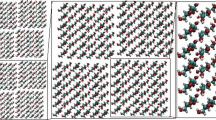Abstract
The heat of vaporization (H vap) of water associated with cellulose fibers versus moisture ratio was determined using modulated differential scanning calorimetry. A steep increase in the H vap for decreasing moisture ratio was observed at low moisture ratios (0.0–0.3 g/g), indicating a higher energy required to evaporate water interacting with the cellulose. The water molecules with elevated H vap correspond to non-freezing bound water. This may be attributed to (a) energy to break mono and/or multilayer sorption and (b) energy to overcome capillary forces. For polypropylene and glass fibers, H vap was constant versus moisture ratio, in agreement with no non-freezing bound water existing in these systems. It is suggested that non-freezing bound water could be used as an indicator of H vap, and vice versa, at low moisture ratios.







Similar content being viewed by others
References
Atalla RH, VanderHart DL (1984) Native cellulose: a composite of two distinct crystalline forms. Science 223(4633):283–285
Aktaş N, Gürese A (2005) Moisture adsorption properties and adsorption isosteric heat of dehydrated slices of Pastirma (Turkish dry meat product). Meat Sci 71(3):571–576
Berlin E, Kliman PG, Pallansch MJ (1970) Changes in state of water in proteinaceous systems. J Colloid Interface Sci 34(4):488–494
Berthold J, Rinaudo M, Salmén L (1996) Association of water to polar groups; estimations by an adsorption model for ligno-cellulosic materials. Colloids Surf A 112(2–3):117–129
Bertran MS, Dale BE (1986) Determination of cellulose accessibility by differential scanning calorimetry. J Appl Polymer Sci 32(3):4241–4253
Ferrasse J-H, Lecomte D (2004) Simultaneous heat-flow differential calorimetry and thermogravimetric for fast determination of sorption isotherms and heat of sorption in environmental or food engineering. Chem Eng Sci 59(6):1365–1376
Fielden KE, Newton JM, O’Brian P, Rowe RC (1988) Thermal studies on the interaction of water and microcrystalline cellulose. J Pharm Pharmacol 40(10):674–678
Gabas AL, Telis-Romero J, Menegalli FC (1999) Thermodynamic models for water sorption by grape skin and pulp. Drying Technol 17(4–5):961–974
Hatakeyama T, Nakamura K, Hatakeyama H (2000) Vaporization of bound water associated with cellulose fibers. Thermochim Acta 352–353:233–239
Hollenbeck RG, Peck GE, Kildsig DO (1978) Application of immersional calorimetry to investigation of solid–liquid interactions: microcrystalline cellulose-water system. J Pharm Sci 67(11):1599–1606
Jeffries R (1964) The amorphous fraction of cellulose and its relation to moisture sorption. J Appl Polymer Sci 8(3):1213–1220
Kumar V, Kothari SH (1999) Effect of compressional force on the crystallinity of directly compressible cellulose excipients. Int J Pharm 177(2):173–182
Liu WG, Yao KD (2001) What causes the unfrozen water in polymers: hydrogen bonds between water and polymer chains? Polymer 42(8):3943–3947
Masuzawa M, Sterling C (1968) Gel-water relationship in hydrophilic polymers: thermodynamics of sorption of water vapor. J Appl Polymer Sci 12(9):2023–2032
Morton WE, Hearle JWS (1993) Chapter 7: Equilibrium absorption of water. Physical properties of textile fibers, 3rd edn. The Textile Institute. Manchester, UK
Mulet A, García-Reverter J, Sanjuán R, Bon J (1999) Sorption isosteric heat determination by thermal analysis and sorption isotherms. J Food Sci 64(1):64–68
O’Sullivan AC (1997) Cellulose: the structure slowly unravels. Cellulose 4(3):173–207
Park S, Venditti RA, Jameel H, Pawlak JJ (2006a) Changes in pore size distribution during drying of cellulose fibers as measured by differential scanning calorimetry. Carbohydr Polym 66(1):97–103
Park S, Venditti RA, Jameel H, Pawlak JJ (2006b) Hard to remove water in cellulose fibers characterized by thermal analysis. Tappi J (Accepted on September 2006) (Also appears in Park S (2006) Doctoral Dissertation, Drying Behavior of Cellulose Fibers Characterized by Thermal Analysis. North Carolina State University.)
Pekarovicova A, Venditti RA, Cao H, Lou YM, Jean YC (1997) Cellulose free volume characterization using positron annihilation lifetime spectroscopy. J Pulp Paper Sci 23(3):101–107
Pu Y, Ziemer C, Ragauskas AJ (2006) CP/MAS 13C NMR analysis of cellulose treated bleached softwood kraft pulp. Carbohydr Res 341(5):591–597
Riedel L (1977) Calorimetric measurement of heats of hydration of foods. Chem Mikrobiol Technol Lebensm 5:97–101
Rückold S, Isengard H-D, Hanss J, Grobecker KH (2003) The energy of interaction between water and surfaces of biological reference materials. Food Chem 82(1):51–59
Sánchez ES, SanJuan N, Simal S, Rosselló C (1997) Calorimetric techniques applied to the determination of isosteric heat of desorption for potato. J Sci Food Agric 74(1):57–63
Shen D, Bülow M (2000) Comparison of experimental techniques for measuring isosteric heat of adsorption. Adsorption – J Int Adsorption Soc 6(4):275–286
Sirota NN (1987) Certain problems of polymorphism. 2. Generalized Clausius-Clapeyron equation and Ostwald step rule. Crystal Res Tech 22(11):1343–1381
Soysal Y, Öztekin S (2001) Sorption isosteric heat for some medicinal and aromatic plants. J Agric Eng Res 78(2):159–166
Weise U, Paulapuro H (1996) Relation between fiber shrinkage and hornification. Das Papier 50(6):328–333
Zang YH, Sapieha S (1991) A differential scanning calorimetric characterization of the sorption and desorption of water in cellulose/ linear low-density polyethylene composites. Polymer 32(3):489–492
Author information
Authors and Affiliations
Corresponding author
Rights and permissions
About this article
Cite this article
Park, S., Venditti, R.A., Jameel, H. et al. Studies of the heat of vaporization of water associated with cellulose fibers characterized by thermal analysis. Cellulose 14, 195–204 (2007). https://doi.org/10.1007/s10570-007-9108-1
Received:
Accepted:
Published:
Issue Date:
DOI: https://doi.org/10.1007/s10570-007-9108-1




